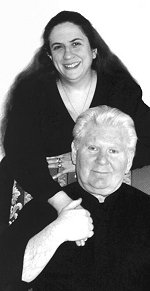|
Tarot Reflections |
February 15, 2005 |
| Presenting Tarot Psychology Wald Amberstone |
||||
|
I work with tarot constantly and as I do, thoughts and problems and issues arise all the time. I keep track of them as they occur in an informal journal. What follows is a journal entry from February, 2003: Last night I attended a lecture at the Gestalt Association for Psychotherapy at the invitation of the presenter, who is a student at The Tarot School. I was surprised at the reception I received, which was cordial, warm, friendly and respectful. My hostess, the presenter, had apparently been saying very nice things about The Tarot School for some time, and this group is less formal and less nervous about issues of professional respectability than others. Their welcome was sincere. By the time the evening was finished, I had been invited to think about making a presentation to this same group sometime in the indefinite future. I was certainly pleased at the prospect, but also a bit uncertain. What approach to take? What to present? Tarot Psychology by this time is fairly rich with technique and very rich with fertile and generative approaches which would be completely new to such a group. But without a tarot background, how much could anyone be expected to learn in a short presentation? Not even as much as the average tarot enthusiast at a conference. But E–, the presenter at this evening's gathering, gave me a clue. She mentioned that part of the purpose of therapy was the discovery and release of the “true self” from beneath the burden of any diagnosis and treatment. I was tempted to ask if she had any idea, from a theoretical standpoint, of where this “true self” might be found and what it might turn out to be. Of course I didn't ask, for courtesy's sake, but later it occurred to me that the burden of Birth Card work, and to a lesser extent, of the Elemental Array, is precisely to discover, and in Ruth Ann's phrase, to “map the true self.” This is the heart of the presentation I would like to make at the GAP. It is a paradigm shift for me. The Psychology of a Magical Being. Mapping the True Self. The discussion would be centered on the human being as a magical being, as a being of many lives and forms, an accumulation of formative impressions as the residue of many dramas. A magical life is far longer and more complex than any of its individual incarnations. Much of the script and set of any incarnation exists before the protagonist takes the stage. The construction of any personal drama is understood in this paradigm to be part karma (with reincarnation as an unspoken given), part dharma (with its whole-hearted acceptance of the tasks implied in all that went before), and part improvisation (the free choice of response to all the unavoidable givens). Birth Cards are seen as the doorposts of a life, the two columns that frame the entrance to the mysteries of an incarnation. So a life, an incarnation, can be understood and enacted as a mystery drama. The temple of circumstance is entered at birth between the columns of a mother's thighs and the inner, earlier, contraction of the Birth Card pair. The drama is played out in the temple and at the end, life exits from the portal of the lips as the final breath. The garment of the physical body is put away, the temple of circumstance is darkened, and the celebrant prepares for the next initiation, the next birth. This is a pretty picture, and one that can be intuitively accepted or denied but neither proven nor disproven. It is beyond analysis or proof. It can only be experienced. One who lives in this experience occupies a universe which becomes more and more identified with and identical to the “true self.” The search for, and immersion in, the true self would seem to be the essence of what is known as spirituality. And spirituality is at the heart of religion and mysticism, which satisfies the vast majority of seekers. But tarot is magic and magic parts company from religion, mysticism and philosophy in that it is supremely pragmatic. It has no inner need or use for spirituality. It does not aspire upward or inward. It climbs no mystic mountain, plumbs no spiritual depths. It explores what is — the known, the unknown, and the unknowable, and it becomes what it explores. Magic is in love with and in awe of the nature of creation. In the end, magic is identical with that love and awe and the mystery at its root. The magician loses the inner human form which is the true shape of spirituality, and becomes a navigator of the unknown. For me, tarot has become a practical compass for the navigation of the unknown.For more information on Wald & Ruth Ann's Tarot School: www.TarotSchool.com |
|||
|
|
||||
|
Subscribe to Tarot Reflections, and receive notification of each update! |
|
Request to be added to the list by sending email to TarotReflections-subscribe@yahoogroups.com! |
All articles remain the
property of their respective authors.
Tarot Reflections is a publication of the American Tarot Association
- Copyright (C) 2005
Questions or Comments? Contact Us.

